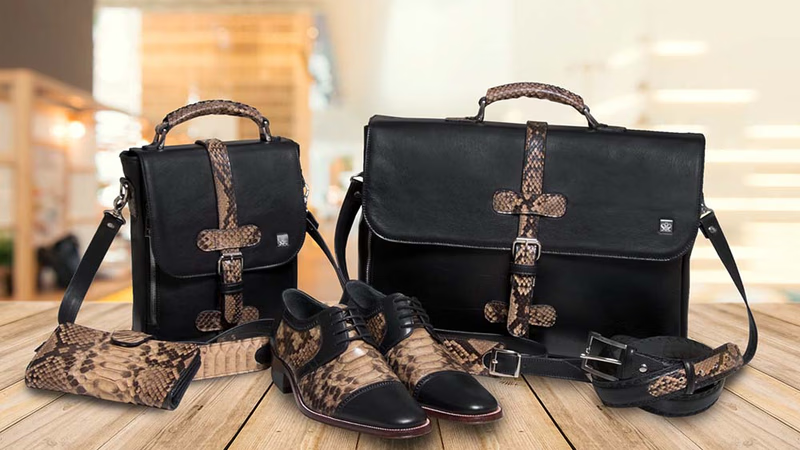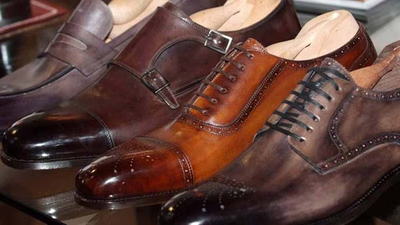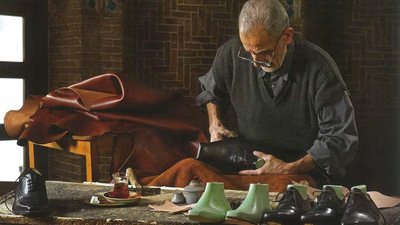
Explore unique handmade bags and shoes from the Middle East.
Traditional hand-embroidered bags and shoes have certain characteristics and details that distinguish them from industrial products. Manufacturers can maintain and emphasize these features to increase their competitive advantage. For example, special hand-embroidered designs and maps, use of natural and local materials, precise and artistic hand-stitching, and preserving the culture and history of the product can be advantages that do not exist in industrial products. To compete with industrial products, manufacturers must maintain high quality in their products. This includes using quality materials, precise and cost-effective tailoring, and providing products with excellent finishing. Providing a high quality product can lead to positive publicity through satisfied people and spreading positive news about the product.
Instead of focusing on one type of traditional bag or shoe, manufacturers can offer more diverse products. It includes a variety of designs, colors, sizes and styles. By offering a variety of options, manufacturers can meet a wider range of customer needs and give them more choice. Using unique and creative marketing strategies can increase competitiveness. This includes building a strong and recognizable brand, using social and online media for advertising and promotion, participating in international exhibitions and events, and building strong relationships with local and international customers and stores. Establishing cooperation with fashion designers and local and international designers can help to develop new and attractive designs and patterns. This collaboration can help innovate and update products and make them reflect new fashion and trends.
Using technology and automation in production processes can help improve quality and productivity. This includes the use of advanced machinery for certain parts of production, the use of management and digital software to improve business processes, and the use of online stores to access global markets. Producers can prepare to compete in the global market by developing exports and international marketing. This includes knowing the target markets, researching the needs and desires of international customers, advertising and selling in target countries and regions, and establishing business relationships with importers and distributors around the world. Training and improving the skills of local artisans can help improve quality and creativity in production. This includes learning new hand embroidery techniques, exploiting new designs and patterns, improving production processes, and accessing educational and technical resources.
Proper marketing and promotion for traditional local hand-made bags and shoes is an important challenge. It is important to be aware of the existence of these products in the world markets and transfer their artistic and cultural value to international customers. For this purpose, there is a need for a proper marketing strategy, creating a distribution network, attending exhibitions and international events, and using social and online media. This can be time consuming and costly for small producers with limited resources. To develop the export of traditional local handmade bags and shoes, government support and incentive policies can be effective. This includes financial facilities, credit facilities, reduced taxes and import duties, export facilities and support for international marketing and advertising. Of course, dependence on government support may create problems for competition in the global market.
Protecting intellectual property rights is also a challenge in the global marketing of traditional local handmade bags and shoes. These products may have special designs, patterns and drawings that require protection. On the other hand, in international markets, the laws of intellectual property rights may be different and complex, and to protect the intellectual property rights of products may require a legal and expensive process. The taste of customers in the global market may change and lean towards modern and newer products. This could mean a decrease in demand for traditional local hand-made bags and shoes. Manufacturers should be able to respond to changes in customers' tastes and revise and update their products in order to have more effective marketing.
To enter the global markets, traditional bags and shoes must meet international technical and quality standards. This includes the use of quality materials, correct and cost-effective tailoring, and compliance with health and safety standards. This may be difficult for small and local handloom producers, as it may require large investments in improving processes and equipment. The global bag and shoe industry generally consists of large manufacturers and an industry that is associated with strong investments and advanced technology. In contrast, traditional local hand-stitched bag and shoe producers are generally smaller in scale and use traditional, manual techniques. This causes them to face direct competition with more economical and industrial products, such as sweeping bags and shoes.
-

Traditional and handmade bags and shoes are vital cultural artifacts that reflect the identity and heritage of various societies. These products often showcase intricate designs, patterns, and textures rooted in local traditions, contributing to cultural preservation and tourism. The craftsmanship involved in creating these items requires significant skill, utilizing techniques such as hand sewing, knitting, and painting. Materials like leather from various animals, cotton, silk, and unique local fabrics are commonly used. Each region has its distinct styles; for instance, Moroccan moccasins feature artistic embellishments while Turkish kilimi bags display traditional woven designs. The appeal of these products lies not only in their aesthetic value but also in their representation of cultural stories and identities. Consumers interested in handicrafts appreciate the artistry and sustainability of handmade items, often seeking unique pieces that reflect personal style while supporting local artisans. Luxury versions made from rare materials like indigo crocodile or parrot skin attract high-end buyers due to their exclusivity. Overall, traditional handmade bags and shoes serve as a bridge between past generations and contemporary culture.
-

Handmade bags and shoes possess unique characteristics that set them apart from industrial products, such as intricate hand-embroidery, local materials, and cultural significance. To enhance competitiveness, manufacturers should focus on maintaining high quality through superior materials and craftsmanship. Diversifying product offerings in terms of designs, colors, and styles can cater to a broader customer base. Innovative marketing strategies are essential; these include building a strong brand presence, leveraging social media, participating in international exhibitions, and collaborating with designers to create appealing products. Technology can also play a role in improving production efficiency and quality. Understanding target markets is crucial for successful exports; this involves researching customer preferences and establishing relationships with global distributors. Training artisans in new techniques can further enhance product quality. However, challenges such as marketing costs, government dependency for support, and protecting intellectual property rights must be addressed. Additionally, manufacturers need to adapt to changing consumer tastes while ensuring compliance with international standards to compete effectively against larger industrial producers.
-

Online commerce has transformed the global market for bags and shoes, enabling businesses to reach international customers efficiently and cost-effectively. This shift allows for a diverse product range, catering to various customer preferences. Consumers benefit from comprehensive product information, facilitating informed purchasing decisions. The convenience of online shopping has altered consumer behavior, leading to increased reliance on digital platforms for purchasing bags and shoes. Traditional retailers face heightened competition from online stores, prompting them to adapt by enhancing their online presence or adopting new strategies. Effective website design, SEO optimization, and active social media engagement are crucial for attracting customers. Online advertising plays a significant role in reaching new audiences, while valuable content creation fosters brand trust. Technologies like augmented reality enhance the shopping experience further.
Data analytics provide insights into customer behavior, allowing businesses to refine marketing strategies and improve sales performance. Customer service excellence is vital for building loyalty, with prompt responses and hassle-free return policies being key factors in customer satisfaction. Overall, the rise of online commerce intensifies competition within the bag and shoe market, driving improvements in product quality and service delivery.
-

The global market for handmade bags and shoes is influenced by various factors, including production centers in Italy, France, England, America, Japan, Spain, Turkey, and Iran. Each region has its unique strengths and styles that contribute to the overall industry. The growth of this market is driven by changing consumer preferences towards quality and sustainable products. Technological advancements such as e-commerce and artificial intelligence are reshaping business models and customer experiences. Additionally, environmental concerns are prompting brands to adopt sustainable practices. The competitive landscape is characterized by the need for innovation in design and materials while adhering to ethical standards. Understanding the supply chain dynamics, including raw material sourcing and distribution logistics, is crucial for businesses aiming to thrive in this sector. Political and economic factors also play a significant role in shaping trade policies that affect the industry.
As global populations grow, particularly in emerging markets like China and India, demand for bags and shoes continues to rise. Social media has become a vital tool for brands to engage with consumers and promote their products effectively. Overall, successful brands must navigate these complexities while focusing on quality improvement and sustainability.




